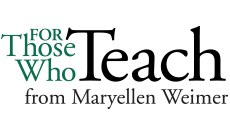Do we communicate more with students in writing than we used to? I think so. In addition to the course syllabus, the usual handouts, and written feedback on papers, projects, and performances, we now share all kinds of electronic messages with students. We exchange emails, post announcements on course management systems, and participate in online discussions. Those who use PowerPoint tend to make rather text-heavy slides. And if you happen to teach online, then virtually all your communication with students occurs via some written format.
 First and foremost, all of these written materials communicate messages about the course and its conduct. But beyond this explicit information are other, more subtle messages. They are conveyed not as much by what we say as by how we say it. Without the benefit of tone, facial expressions, and other nonverbal cues, written communication creates new challenges for establishing a positive learning environment.
First and foremost, all of these written materials communicate messages about the course and its conduct. But beyond this explicit information are other, more subtle messages. They are conveyed not as much by what we say as by how we say it. Without the benefit of tone, facial expressions, and other nonverbal cues, written communication creates new challenges for establishing a positive learning environment.
Several parameters guide our written communication with students. We need to be polite, and most of us are. We need to be professional, and most of us don’t have a problem with that either. But we also a need to be personable. There’s all sorts of evidence that creating personal connections with students has a positive effect on learning experiences, but how much thought do we give to making those connections in writing?
It was an interesting study of syllabi that got me thinking about this. The researchers created two syllabi. The first contained language they equated with teacher-centered approaches—lots of directives and focus on the course content. The second was more learner-centered and described not just on what students would be learning but also how they would be learning. A cohort of students looked at each syllabus and then answered a series of questions about the course and its instructor. Based on the syllabus alone, these students attributed teacher-centered or learner-centered characteristics to the hypothetical professors they had been told authored each syllabus.
It reminded me of an activity I used in my graduate course on college teaching. I assembled a set of syllabi from courses taught by instructors I knew and had observed teach. After removing all the identifying information, I had small groups review a syllabus and share their impressions of the course and instructor. Each time, their descriptions of both were amazingly accurate.
The syllabi study did not consider how impressions about the course and instructor are mediated when the teacher presents and discusses the syllabus in person. But often the syllabus is now a stand-alone introduction to the course and instructor. That’s almost always the case in online courses, but even in face-to-face courses the syllabus is often posted on the course website before the class convenes. So, students start to form their impressions before the first class.
I wonder if we are as aware of the “tonal” messages in our written communications as we should be. Often, we have so many assignments to grade that we get tired and the comments can become cryptic. Students, personally vested in their work, respond viscerally to teacher comments, especially those that point out flaws. Yes, they need to grow up and learn from negative feedback, but growing up is a process. How can we make it a constructive experience?
Connecting with students—being personable in our prose—is a matter of style, which means the options are many and the best choices are ones that fit comfortably with our teaching identities. I’d like to encourage us to explore how we’re coming across in our writing. Take a look at the last few emails you sent to students. Read some of the comments on those assignments you’re about to return. Review your latest contributions to the ongoing online discussion. Does the writing have a voice and sound like it’s written by a real person? Is the tone constructive? Does it convey an unwavering belief in the ability of students to learn? If not, what changes can you make?
Reference: Richmond, A. S., Slattery, J. M., Mitchell, N., Morgan, R. K., and Becknell, J. (2016). Can a learner-centered syllabus change students’ perceptions of student-professor rapport and master teacher behaviors? Scholarship of Teaching and Learning in Psychology, 2 (3), 1-10.
© Magna Publications. All rights reserved.







2 Responses
Dr. Weimer, thank you so much for your insights regarding writing to students and how we are communicating through our words. The research you cited demonstrates just how powerful and personal our words can be. Allow me to share my blog on this very topic: https://bdavismcdp.wordpress.com/2018/01/10/why-i-never-say-quote-unquote/ Thank you for your challenge to all educators!
It is far too easy to quickly jot down a peremptory response to an assignment in support of the grade I select. For this reason, I take the time to consider the vocabulary and tenor of my writing before replying. I love the questions you provided to help each educator take a long, hard look at the impact of their words and the powerful potential to challenge and inspire each student.